The Enlightenment Configuration Tool
There are two ways to launch the Enlightenment Configuration tool (E-conf). You can open the GNOME Control Center and select the Window Manager Capplet from the Desktop group. If you have Enlightenment as your current window manager you can run E-conf by pressing the Run Configuration Tool for Enlightenment button.
You can also launch E-conf by clicking your middle mouse button (or both right and left mouse buttons if you have emulation) on the desktop and selecting the Enlightenment Configuration item from the pop-up menu.
E-conf is divided into many sections that control various effects and functions within Enlightenment (E). You will find a list of these sections in the top left corner of the E-conf. The sections to choose from include: Basic Options, Desktops, Behavior, Audio, Special FX, Backgrounds, Themes, and Shortcuts.
Basic Options
The Basic Options section of E-conf lets you configure how E controls the movement and focus of windows on your desktop. Each method for controlling windows has a small image to show you what they look like, but perhaps the best way to get a feel is to select one, press the Apply button and move the window around. There are three areas to configure: Move Methods, Resize Methods, and Keyboard focus follows.
Figure 11-1. Enlightenment Basic Options
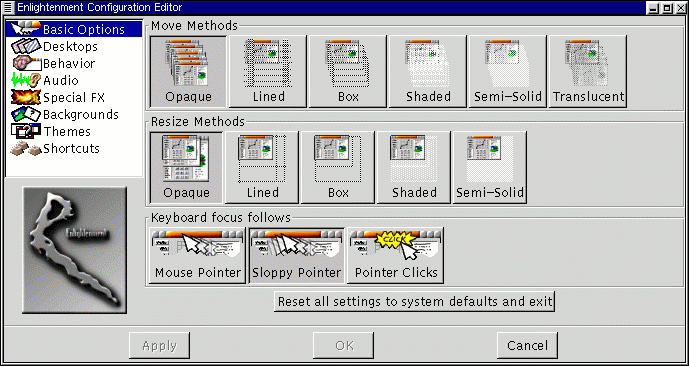
Move Methods - This area controls the way windows look when you move them around your desktop with your mouse. You can choose from Opaque, Lined, Box, Shaded, Semi-Solid, and Translucent. Depending on your machine speed some of these move methods may work slower than others.
Resize Methods - The Resize Methods option controls how the windows look when you resize them. You can choose among Opaque, Lined, Box, Shaded, and Semi-Solid. Again, depending on your machine speed some of these methods may work slower than others.
Keyboard focus follows - This area controls which window gets the focus. Getting the focus means that the keyboard can control the window and if there is a distinction in you enlightenment theme, the window will be highlighted. You can choose from Mouse Pointer, Sloppy Focus, and Pointer Clicks.
Mouse Pointer will focus the window whenever the mouse is over the window. Sloppy Pointer will do the same but will focus the window when the mouse is over it and keep the focus until the mouse is over another window. For example, you can put the mouse over a window and then over the desktop and the window will still have focus until it is over another window. Pointer Clicks means that you have to actually click on the window to give it focus.
At any time you can reset all of the Enlightenment configurations to the default settings by pressing the Reset all settings to system defaults and exit button.
Desktops
As you read in the section called Desktop Areas in Chapter 13, GNOME supports the use of multiple desktop areas, and for the advanced user, multiple desktops. The control over these areas and desktops is actually handled by the window manager. The Enlightenment Configuration tool allows you to change the number of areas and desktops you have use of in your work environment.
Figure 11-2. Enlightenment Desktops
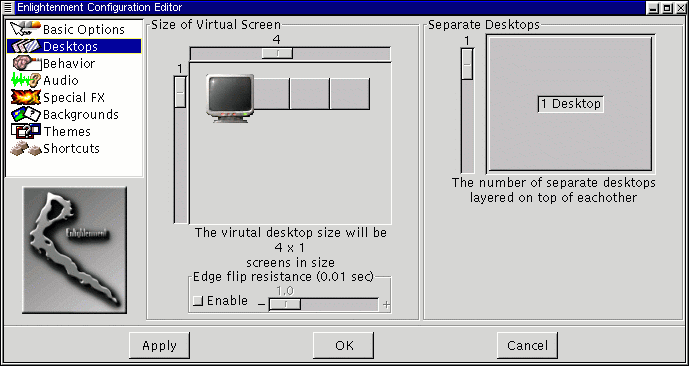
The Desktops Section of E-conf has two main tools to let you change the number of areas and desktops you use. The first tool is the Size of Virtual Screen which controls the number of desktop areas. Desktop areas are really just one big screen broken into many "virtual areas". The advantage to using virtual areas over multiple desktops is that drag and drop on the desktop will work across areas as will work being done in applications such as the GNOME File Manager. To use this tool slide the two sliders until you have the number of virtual areas, across and down, that you wish to use.
The second tool is Separate Desktops, which allows you to set the number of desktops you wish to use. Unlike desktop areas these are completely separate desktops. To use this tool move the slider up or down until you have the number of desktops you wish to use.
One good way to visualize your multiple areas/desktops situation is to make sure you have the GNOME Pager running. The GNOME Pager will show you how many areas and desktops you have and where your applications are within those spaces. You can also use the GNOME Pager to navigate from area to area and desktop to desktop. You can read more about the GNOME Pager in the section called GNOME Pager in Chapter 19.
Edge resistance factor for auto flip - If you are using desktop areas you can choose to have the areas switch when your mouse goes past the edge of the screen in the direction of another area. If you do have this feature on you can change the resistance the mouse has when it is moving past the edge by moving the slider to the number of seconds it takes to change to the next desktop.
Behavior
The Behavior Section of E-conf allows you to control various focus and miscellaneous behaviors in E.
Figure 11-3. Enlightenment Behavior
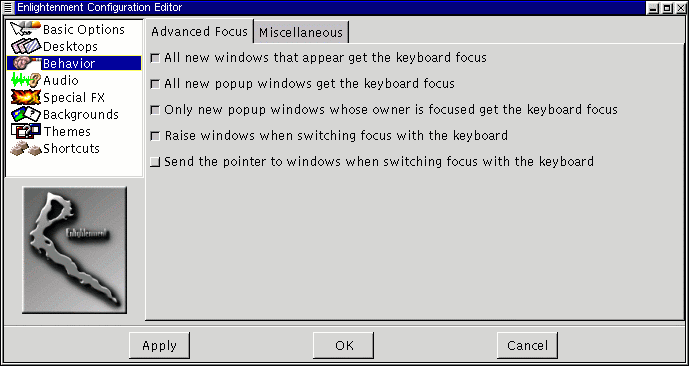
Advanced Focus - This tab allows you to change properties related to focusing windows.
All new windows that appear get the keyboard focus - This ensures that when you start a new application you can start working on it when it appears without moving the mouse to get the focus of the window.
All new pop-up windows get the keyboard focus - This will give the focus to new pop-up windows only. If you have this selected and the "All new windows that appear get the keyboard focus" not selected, your pop-ups will get the focus no matter where they appear, but new applications started will not. An example of a pop-up window is an error message you might get in an application.
Only new pop-up windows whose owner is focused get the keyboard focus - This will give the focus to new pop-up windows only if the application that launched the window has the focus beforehand.
Raise windows when switching focus with the keyboard - If you use keystrokes to change the focus of your windows this will bring the focused window to the foreground.
Send pointer to windows when switching focus with the keyboard - If you use keystrokes to change the focus of your windows, this will send your mouse pointer to the focused window.
Miscellaneous - This tab has miscellaneous Enlightenment behaviors.
Tooltips ON/OFF & timeout for tooltip pop-up - This controls whether you would like tooltips to display on various parts of an Enlightenment-controlled window. A tooltip is a small information window which opens when your mouse pointer hovers over an element in an application or component. The time slide bar next to the button lets you change how long it takes for the tooltips to appear once your mouse is over a component controlled by E. The speed is measured in seconds.
Automatic raising of windows after X seconds - This will focus a non-focussed window after the seconds you specify when your mouse is over it.
Transient pop-up windows appear together with leader - If your application brings up small pop-up windows as part of its normal function this will ensure that those pop-up windows stay with the main window. This can be helpful if your work flow is interrupted by the pop-up window showing up on the opposite side of your screen while you are working.
Switch to where pop-up window appears - This will send the mouse cursor and keyboard control to any pop-up window that appears on the desktop.
Display icons when windows are iconified - If you check this option and minimize your window this will display available icons for the application running in the window onto a tile that is created. If you are using the GNOME Pager you do not need to enable this option as it will allow you to access minimized applications.
Place windows manually - If you wish to place a new window yourself this will give the mouse the placement control of any new window.
Audio
You can turn on Enlightenment's own sound events in this section.
Special FX
The Special FX Section on E-conf controls various special effects that E can use to control windows. If you have a slower machine you might consider disabling these features in this section.
Figure 11-4. Enlightenment Special Effects

Windows Sliding Methods - This area controls what windows look like when they slide in on first display. You must have the slide in feature enabled for these to work. You can choose from Opaque, Lined, Box, Shaded, and Semi-Solid.
Windows slide in when they appear - This is where you can turn on or off the special effect of windows sliding in. To turn it on or off press the small button beside the speed slide bar. The speed slide bar controls how fast the windows slide and is based on pixels per second.
Windows slide about when cleanup in progress - This controls the special effect of windows sliding in when you select the Cleanup Windows menu item from the Enlightenment menus. To turn it on or off press the small button beside the speed slide bar. The speed slide bar controls how fast the windows slide about and is based on pixels per second. For more information about the Cleanup Window function see the section called Enlightenment Menus.
Desktops slide in when changed - If you use multiple desktops this will make the desktops slide in when you switch to a new one. To turn it on or off press the small button beside the speed slide bar. The speed slide bar controls how fast the desktop slides in and is based on pixels per second.
Window shading speed - If you choose to have this option you can shade a window by double clicking on its title bar. Shading will draw the body of the window up into the title bar so that you only see the title bar on the screen. Another double click will return the window to it's original state. The time slide bar next to the button controls how fast this behavior works. The speed is measured in pixels per second.
Drag bar - Some Enlightenment themes will include a Drag bar which allows you to slide and peak into the next Desktop area or Desktop. If you wish not to have this on, make sure it is not selected. You can also decide where to place the Drag bar if you do have it enabled.
Animate Menus - This will control the way Enlightenment menus are displayed. The menus will be animated if you enable this feature by pressing the small button.
Reduce refresh by using more memory - This will place menus into memory to speed them up. Depending on your menus this can place a sizeable hit on your system memory.
Backgrounds
You can choose to let Enlightenment control your desktop background images. Setting the background is controlled in this area of the Enlightenment Configuration tool.
IMPORTANT: If you do choose to have Enlightenment set the desktop background you will not be able to use the GNOME Control Center's Background Properties Capplet. If you are new to GNOME or Enlightenment it is recommended that you do not use this feature.
Figure 11-5. Enlightenment Backgrounds
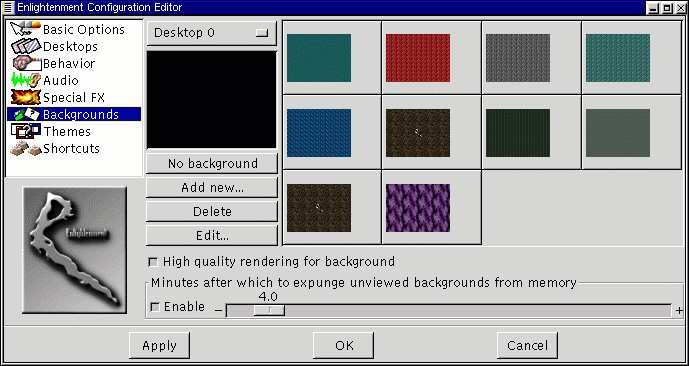
Setting the Background
The Enlightenment background selector acts as much as a file viewer for your backgrounds as it does a creator of them. You will notice first that there is a large area to preview the backgrounds. This area is not only a good place to preview your backgrounds but it acts as an area for "bookmarking" them.
To set a background for your desktop you must first choose which desktop you want to set the background for. The top button which reads Desktop 0 will show you which desktop you are setting the background for. If you want to set it for another desktop you can press the button and select the proper desktop.
NOTE: Desktop 0 is the first desktop in any series of desktops. If you are using virtual areas on one desktop it is Desktop 0 as well.
Once you have chosen the desktop you wish to set a background for you can select a background for that desktop. To select one simply locate the image or color in the collection on the right of the preview area or select the No background button.
If you do not like the selections in your collection you can create a new one. You will find more information about making a new background in the next section.
NOTE: If you select the No Background button for a desktop, another application or the GNOME Control Center's Background Properties Capplet can set the background for that particular desktop.
Creating a New Background
To create a new background you must first press the Add new button to start adding the new background to the current collection of backgrounds on the right. This will add a new box to the collection which will be blank at first.
You can start to edit the new image by selecting the new box you have just added and pressing the Edit button. This will bring up the Edit Background dialog which allows you to set the background image.
The Edit Background dialog contains three tabs which represent three different types of backgrounds you can have: Solid Color, Gradient, Background Image, and Overlayed Logo.
Figure 11-6. Solid Color Background

Solid Color - This tab is simply a color selector and color properties slidebars which allow you to choose the solid color you wish to use for your background.
Figure 11-7. Gradient Color Background
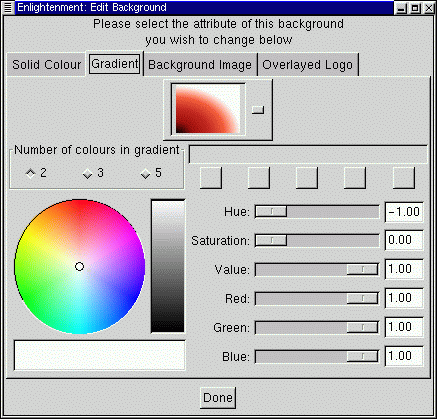
Gradient - This tab combines the color selector and color properties slide bars with a choice of how many colors you would like in the gradient. You can select as many as five colors but you must specify the color for each selection.
Figure 11-8. Background Image

Background Image - This tab allows you to select an image on your system to display as your background. You can press the Browse button to find the image and the None button to clear any selected image.
Once you have found the image you want you can decide whether the image should repeat as tiles across the screen, retain its own aspect ratio, maximize its height to fit the screen, or maximize its width to fit the screen.
Figure 11-9. Overlayed Logo

Overlayed Logo - This tab will allow you to overlay an image on the background you have already set in the other tabs. You can search for the correct image with the Browse button and clear any selection with the None button.
Once you have found the image you wish to overlay you can select where you would like the image to be displayed with the placement drop-down list. You can also decide if you want to maintain the image's original aspect ratio, maximize its height to fit the screen, or maximize its width to fit the screen.
When you have completed editing your image, press the Done button to return to E-conf.
Themes
Enlightenment is known for many things to the Linux community, not least of which is the sometimes fantastic and personalized look. This can be attributed to the one of the most fun features of Enlightenment, support of themes. These themes have been created by Raster and many E users throughout the world. In fact, a Web site has been set up to be a repository of E themes, http://e.themes.org.
Figure 11-10. Enlightenment Themes
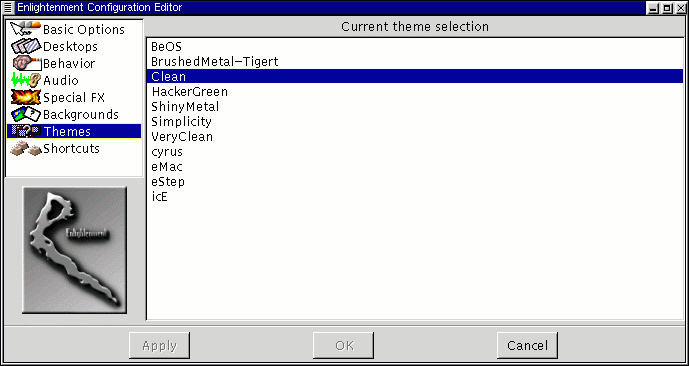
E themes must have an extension of .etheme to work. Some themes might be made for older version of Enlightenment and will not work with the newest release so make sure you are getting a compatible version.
Once you have found a theme you would like to have for E you must put it in your
~/.enlightenment/themes/ |
To change themes select the theme you would like in the list of available themes and press the Apply button on the bottom of the E-conf.
Keyboard Shortcuts
The Keyboard Shortcuts section will allow you to change the keyboard shortcuts used for controlling windows, starting commands, and navigating between windows, areas, and desktops.
Figure 11-11. Enlightenment Keyboard Shortcuts
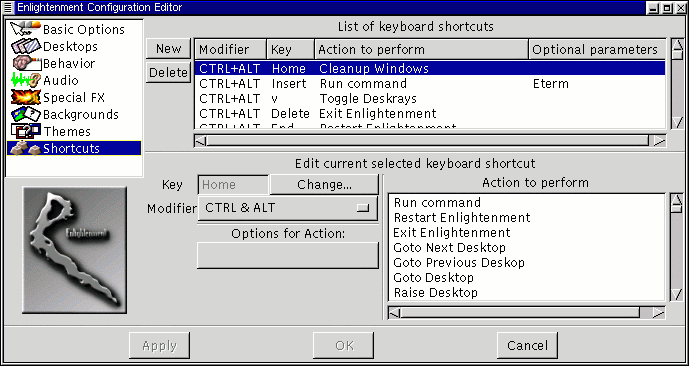
The Keyboard Shortcuts section is divided into two main areas, List of keyboard shortcuts and the Edit current selected keyboard shortcut.
In the List of keyboard shortcuts you can see which shortcuts have already been defined and select them to edit. You can also add new shortcuts by pressing the New button and delete them by pressing the Delete button.
The Edit current selected keyboard shortcut area is where you actually define what the keyboard shortcut will be. To use this area, you must select the shortcut you wish to edit, or select a newly added shortcut after you press the New button. Once a shortcut has been selected you can change the keys it uses or even the function it performs.
To change the keys used for a shortcut press the Modifier selection button and select which modifiers you wish to use. Modifiers are the keys ALT, CTRL, and SHIFT. You can select one modifier or a combination of modifiers to use with your shortcut.
At this point you will also need to change the key being used by pressing the Change button beside the Key definition box. Once you press the Change button you will receive a short message pop-up window which will tell you to press the desired key. Press the key and the definition will be changed.
To assign the new shortcut to an action simply scroll though the Action to perform list and select the action you wish to perform with this shortcut.
Some keystrokes you wish to use might have an action that needs defining. For example, if you wish to use a keyboard shortcut to change to a particular desktop you can select Goto Desktop. In the Options for Action you can define which desktop you want to go to by typing in the correct number.